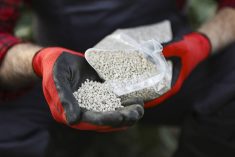If you take the nitrogen out of the equation for lake algal blooms it turns out you really haven’t changed things at all.
According to researchers at the Experimental Lakes Area, operated by Winnipeg’s International Institute for Sustainable Development, that’s because many of the algae responsible for the harmful blooms can turn around and fix their nitrogen from the air. Instead, they say you would need to concentrate on limiting phosphorus loading into the surface water bodies.
- Read more: The phosphorus conundrum: low soil levels meet Lake Winnipeg pressures
- Read more: Phosphorus recovery can complement source reduction
Read Also

Manitoba farmers uneasy on expropriation
Farmland expropriation for Oak Bluff highway project brings process, farmer compensation concerns back to the fore.
This is according to a recently published article in Springer’s Ecosystems journal that presents the results of a 46-year whole-ecosystem experiment.
Since 1969, researchers have been artificially manipulating a lake by adding varying amounts of carbon, nitrogen, and phosphorus to investigate the nutrients responsible for algal blooms. Throughout the experiment, researchers have been continually adding phosphorus.
However, 40 years ago, researchers began reducing the amount of nitrogen they were adding to the lake, and from 1990-2013, they cut artificial nitrogen loading to zero. Despite these dramatic cuts in nitrogen loading, algal blooms continued to cover the lake.
“We have been researching the role of artificial nitrogen in algal blooms for almost 50 years now, and these latest results clearly demonstrate that ceasing nitrogen loading into lakes has little effect on the size or duration of algal blooms,” said Scott Higgins, lead author on the paper.
The research team says the study clearly shows that phosphorus should be the key target when tackling the issue, especially with limited resources.















